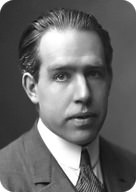3.15 Bohr的原子能模型
章节大纲
-
Look at the people in the picture. Do you see how they are standing on different rungs of the ladder? When you stand on a ladder, you can stand on one rung or another, but you can never stand in between two rungs. A ladder can be used to model parts of an . Do you know how?
::看看照片中的人。 你能看到他们如何站在梯子上? 当你站在梯子上时, 你可以站在一个或另一个的梯子上, 但你永远不能站在两个梯子之间。 一个梯子可以用来模拟一个梯子的部位。 你知道如何吗 ?Modeling the Atom
::模拟原子The existence of the atom was first demonstrated around 1800 by John Dalton. Then, close to a century went by before J.J. Thomson discovered the first subatomic particle, the negatively charged . Because atoms are neutral in charge, Thomson thought that they must consist of a sphere of positive charge with electrons scattered through it. In 1910, Ernest Rutherford showed that this idea was incorrect. He demonstrated that all of the positive charge of an atom is actually concentrated in a tiny central region called the nucleus . Rutherford surmised that electrons move around the nucleus like planets around the sun. Rutherford’s idea of atomic structure was an improvement on Thomson’s model, but it wasn’t the last word. Rutherford focused on the nucleus and didn’t really clarify where the electrons were in the empty space surrounding the nucleus.
::约翰·道尔顿(John Dalton)在1800年左右首次证明了原子的存在。 然后,在J.J.Thomson发现第一个亚原子粒子之前的近一个世纪已经过去了,这个粒子被负电压了。由于原子是中立的,汤姆森认为它们必须包含一个对通过原子散布的电子进行正电荷的球体。 1910年,欧内斯特·卢瑟福(Ernest Rutherford)表明这一想法是不正确的。他证明原子的所有正电荷实际上都集中在一个叫做核的极小中心区域。露瑟福(Rutherford)推测,电子在核周围移动,就像太阳周围的行星一样。卢瑟福(Rutherford)的原子结构概念是Thomson模型的改进,但不是最后一个词。卢瑟福(Luterford)专注于核,并没有真正澄清核心周围的空空空空空间中的电子在哪里。The next major advance in atomic history occurred in 1913, when the Danish scientist Niels Bohr published a description of a more detailed model of the atom. His model identified more clearly where electrons could be found. Although later scientists would develop more refined atomic models, Bohr’s model was basically correct and much of it is still accepted today. It is also a very useful model because it explains the properties of different . Bohr received the 1922 Nobel prize in physics for his contribution to our understanding of the structure of the atom. You can see a picture of Bohr .
::原子史的下一个重大进步发生在1913年,当时丹麦科学家尼尔斯·伯赫尔发表了关于原子更详细模型的描述。他的模型更清楚地确定了可以找到电子的地方。 尽管后来的科学家将开发更精细的原子模型,但布尔的模型基本上是正确的,大部分今天仍然被接受。 这也是个非常有用的模式,因为它解释了不同特性。 布尔获得1922年诺贝尔物理学奖,是因为他为我们了解原子结构作出了贡献。 你可以看到博尔的图片。On the Level
::各级As a young man, Bohr worked in Rutherford’s lab in England. Because Rutherford’s model was weak on the position of the electrons, Bohr focused on them. He hypothesized that electrons can move around the nucleus only at fixed distances from the nucleus based on the amount of they have. He called these fixed distances energy levels, or electron shells. He thought of them as concentric spheres, with the nucleus at the center of each sphere. In other words, the shells consisted of sphere within sphere within sphere. Furthermore, electrons with less energy would be found at lower energy levels, closer to the nucleus. Those with more energy would be found at higher energy levels, farther from the nucleus. Bohr also hypothesized that if an electron absorbed just the right amount of energy, it would jump to the next higher . Conversely, if it lost the same amount of energy, it would jump back to its original energy level. However, an electron could never exist in between two energy levels. These ideas are illustrated in the Figure .
::伯尔作为一个年轻人,在英国的卢瑟福德实验室工作。由于卢瑟福德的模型在电子的位置上很弱,伯尔专注于这些电子。他假设电子只能在离核的固定距离内移动核心。他将这些固定距离能量水平称为固定距离能量水平,或电子壳。他认为它们是同心球,每个球体的中心是核心。换句话说,炮弹由球体内的球体组成。此外,能量较少的电极将被发现在低能量水平上,靠近核。能量较多的电极将被发现在更高的能量水平上,离核更远。博尔还假设,如果电能吸收到正确的能量数量,它就会跳到下一个更高的水平。相反,如果它失去同样的能量数量,它就会跳回原来的能量水平。然而,电子将永远无法存在于两个能量水平之间。这些想法将在图中说明。This is a two-dimensional model of a three-dimensional atom. The concentric circles actually represent concentric spheres. Q: How is an atom like a ladder?
::问:原子像梯子一样如何?A: Energy levels in an atom are like the rungs of a ladder. Just as you can stand only on the rungs and not in between them, electrons can orbit the nucleus only at fixed distances from the nucleus and not in between them.
::A:原子中的能量水平就像梯子的吊圈。正如你只能站在吊圈上而不是中间一样,电子只能在离核的固定距离内运行核,而不是在它们之间的固定距离内运行。Energy by the Spoonful
::誓以用电能和电能,Bohr’s model of the atom is actually a combination of two different ideas: Rutherford’s atomic model of electrons orbiting the nucleus and German scientist Max Planck’s idea of a quantum, which Planck published in 1901. A quantum (plural, quanta) is the minimum amount of energy that can be absorbed or released by matter. It is a discrete, or distinct, amount of energy. If energy were water and you wanted to add it to matter in the form of a drinking glass, you couldn’t simply pour the water continuously into the glass. Instead, you could add it only in small fixed quantities, for example, by the teaspoonful. Bohr reasoned that if electrons can absorb or lose only fixed quantities of energy, then they must vary in their energy by these fixed amounts. Thus, they can occupy only fixed energy levels around the nucleus that correspond to quantum increases in energy.
::博尔的原子模型实际上是两种不同想法的组合:卢瑟福德的原子电子模型环绕核体和德国科学家马克斯·普朗克的量子设想 — — Planck于1901年发表了这一想法。 量子(多元的,夸特的)是物质能吸收或释放的最小能量量。 这是一个离散的或截然不同的能量量。 如果能量是水,而你想以饮料的形式将能量添加到物质中,那么你就不能简单地将水持续倒入玻璃中。 相反,你只能用少量固定的数量添加,比如用茶匙。 伯尔认为,如果电子能吸收或只损失固定数量的能量,那么它们必须用这些固定的数量来改变能量。 因此,它们只能占据核心周围与能源量增长相对的固定能源水平。Q: The idea that energy is transferred only in discrete units, or quanta, was revolutionary when Max Planck first proposed it in 1901. However, what scientists already knew about matter may have made it easier for them to accept the idea of energy quanta. Can you explain?
::问题:能源仅以离散单位或夸特转移的想法在1901年马克斯·普朗克首次提出时是革命性的。 然而,科学家们已经知道的关于物质的知识也许使他们更容易接受能量夸特的想法。你能解释一下吗?A: Scientists already knew that matter exists in discrete units called atoms. This idea had been demonstrated by John Dalton around 1800. Knowing this may have made it easier for scientists to accept the idea that energy exists in discrete units as well.
::甲:科学家已经知道物质存在于被称为原子的离散单元中。约翰·道尔顿已经证明了这一想法。知道这一点也许使科学家更容易接受离散单元中存在能源的想法。Summary
::摘要-
In Bohr’s atomic model, electrons move around the nucleus only at fixed distances from the nucleus based on the amount of energy they have. The fixed distances where electrons may orbit are called energy levels.
::在博尔的原子模型中,电子在核心周围的移动仅以其能量为基础,与核心保持固定距离。 电子在轨道上运行的固定距离被称为能量水平。 -
Bohr arrived at his model by applying Planck’s idea of energy quanta to Rutherford’s atomic model of electrons orbiting the nucleus.
::将普朗克的能源夸特想法应用到卢瑟福的核轨道上电子原子模型中。
Review
::回顾-
How does Bohr’s atomic model build on Rutherford’s model?
::博尔的原子模型如何以卢瑟福的模型为基础? -
Explain the connection between energy quanta and energy levels.
::解释能量量与能量水平之间的联系。 -
How does Bohr’s work demonstrate the importance of communication in science?
::Bohr的工作如何证明交流在科学中的重要性?
Resources
::资源 -
In Bohr’s atomic model, electrons move around the nucleus only at fixed distances from the nucleus based on the amount of energy they have. The fixed distances where electrons may orbit are called energy levels.


